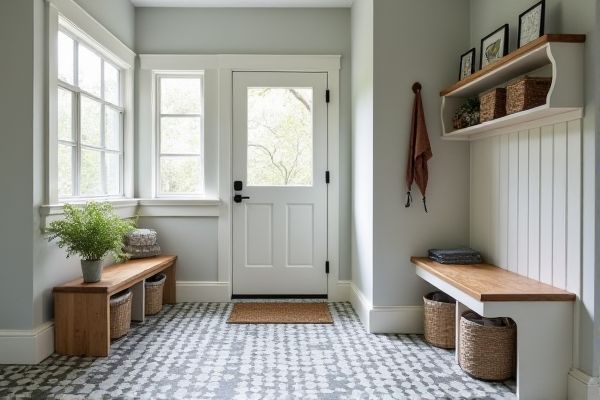
Grey tile offers a sleek, neutral backdrop that easily complements various mudroom styles and colors, while patterned tile adds visual interest and personality, making the space feel lively and welcoming. Discover which option suits Your mudroom best by exploring the benefits, maintenance tips, and design ideas in the rest of this article.
Table of Comparison
| Feature | Grey Tile | Patterned Tile |
|---|---|---|
| Visual Appeal | Neutral, minimalist, modern look | Bold, decorative, adds character |
| Maintenance | Easy to clean, hides dirt moderately | Camouflages dirt and stains better |
| Durability | Highly durable, suitable for high traffic | Equally durable, depends on tile material |
| Style Compatibility | Works with modern, industrial, minimalist styles | Fits eclectic, vintage, farmhouse designs |
| Installation Cost | Generally lower cost | Can be higher due to complexity |
| Slip Resistance | Standard slip resistance | Often textured for added grip |
| Resale Value Impact | Neutral, widely appealing | Can raise value if tastefully done |
Grey Tile vs Patterned Tile: Which is Best for Your Mudroom?
Grey tile offers a sleek, modern look and versatility, making it ideal for a mudroom that needs durability and easy maintenance. Patterned tile introduces visual interest and personality, often serving as a focal point that can brighten up the entry space and mask dirt between cleanings. Choose grey tile for minimalist, timeless design or patterned tile for a bold, decorative statement that enhances your mudroom's character.
Aesthetic Appeal: Neutral Grey vs Eye-Catching Patterns
Neutral grey tiles offer a timeless and versatile aesthetic that seamlessly complements various mudroom styles, providing a calm and cohesive backdrop. Patterned tiles create an eye-catching focal point, adding personality and vibrancy to the space while concealing dirt and wear more effectively. Choose grey for understated elegance or patterned for a bold statement that reflects your unique taste.
Durability and Maintenance: Comparing Grey and Patterned Tiles
Grey tiles in mudrooms offer superior durability due to their typically dense glaze and uniform surface, making them highly resistant to scratches and stains. Patterned tiles, while visually striking, may require more careful maintenance to prevent dirt accumulation in grooves or intricate designs. Both types are generally easy to clean, but grey tiles often outperform patterned ones in low-maintenance durability for high-traffic areas like mudrooms.
Mudroom Functionality: Slip Resistance and Tile Choice
Grey tile offers excellent slip resistance and durability, making it a practical choice for mudrooms exposed to moisture and dirt. Patterned tile provides added visual interest but may require careful selection to ensure textured surfaces prevent slipping effectively. Prioritizing slip-resistant materials with certified ratings like R10 or higher enhances safety while maintaining functional design in mudroom flooring.
Design Flexibility: Coordinating Grey and Patterned Tiles
Grey tiles offer a neutral foundation that enhances design flexibility, making it easier to coordinate with patterned tiles in your mudroom. Muted tones in grey tiles allow bold, intricate patterns to stand out without overwhelming the space, creating balanced visual interest. Combining these tile styles can maximize aesthetic appeal while maintaining cohesion in your mudroom design.
Cost Comparison: Grey Tiles Versus Patterned Alternatives
Grey tiles typically offer a more budget-friendly option compared to patterned tiles, with standard grey ceramic or porcelain tiles costing between $2 to $5 per square foot. Patterned tiles, especially those with intricate designs or hand-painted details, can range from $6 to $15 per square foot, increasing overall mudroom renovation expenses. Opting for grey tiles provides a cost-effective solution while patterned alternatives add aesthetic value and character at a higher price point.
Installation Tips for Grey and Patterned Tiles in Mudrooms
Grey tiles offer a sleek, modern look with easy installation due to their uniform color and texture, simplifying grout color matching and pattern alignment. Patterned tiles require precise planning and layout to ensure designs align seamlessly, so dry-laying tiles first helps prevent mistakes and uneven patterns. Your mudroom installation benefits from using high-quality adhesive and grout suited for high-traffic, moisture-prone areas to maximize durability and maintain appearance.
Cleaning and Stain Resistance: What Works Best?
Grey tiles offer superior stain resistance and ease of cleaning due to their uniform color and non-porous surfaces, making them ideal for high-traffic mudrooms. Patterned tiles can mask dirt and minor stains effectively but may require more meticulous cleaning to maintain grout lines and vibrant designs. Your choice depends on whether you prioritize quick maintenance with grey tile or aesthetic versatility with patterned options.
Popular Styles: Trending Grey and Patterned Tiles for Mudrooms
Trending grey tiles for mudrooms include matte porcelain with concrete-inspired textures and large-format slate-look designs, offering a sleek, modern aesthetic. Patterned tiles feature bold geometric shapes, Moroccan motifs, and vintage encaustic styles, providing vibrant contrast and visual interest in transitional spaces. Both options optimize durability and ease of maintenance, making them popular choices for high-traffic mudroom areas.
Final Verdict: Choosing the Right Tile for Your Mudroom
Grey tile offers a sleek, versatile look that complements various design styles and hides dirt effectively, making it ideal for high-traffic mudrooms. Patterned tile brings visual interest and personality, transforming the mudroom into a focal point with unique textures and colors. The final verdict depends on balancing practicality and aesthetics: grey tile suits those seeking durability and simplicity, while patterned tile appeals to homeowners prioritizing bold design statements.
 homyna.com
homyna.com